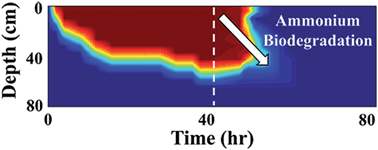当前位置:
X-MOL 学术
›
Environ. Sci.: Processes Impacts
›
论文详情
Our official English website, www.x-mol.net, welcomes your feedback! (Note: you will need to create a separate account there.)
Nitrification in a soil-aquifer treatment system: comparison of potential nitrification and concentration profiles in the vadose zone†
Environmental Science: Processes & Impacts ( IF 5.5 ) Pub Date : 2017-11-21 00:00:00 , DOI: 10.1039/c7em00402h Alexander Sopilniak 1, 2, 3, 4, 5 , Roy Elkayam 1, 2, 3, 4, 5 , Ovadia Lev 1, 2, 3, 4, 5
Environmental Science: Processes & Impacts ( IF 5.5 ) Pub Date : 2017-11-21 00:00:00 , DOI: 10.1039/c7em00402h Alexander Sopilniak 1, 2, 3, 4, 5 , Roy Elkayam 1, 2, 3, 4, 5 , Ovadia Lev 1, 2, 3, 4, 5
Affiliation

|
The oxidation of ammonium in the vadose zone of soil aquifer systems is discussed and examined by detailed analysis of the depth profiles of dissolved oxygen, nitrate and ammonium concentrations in the vadose zone of a soil-aquifer treatment (SAT) system of a municipal wastewater treatment system of the Tel Aviv metropolitan area. Nitrification kinetics and ammonium adsorption capacity studies show that neither the nitrification rate nor the ammonium adsorption capacity controls the capacity of the Shafdan SAT system for ammonium removal. Evaluation of the ammonium adsorption capacity of the soil reveals that under ideal conditions, a depth of less than 50 cm is sufficient to adsorb all the ammonium supplied in a flooding cycle. In-field studies show that all the ammonium is concentrated within the first 80 cm of the vadose zone. A depth profile of the Potential Nitrification (P.N), a measure of the local amount and activity of nitrifiers, is presented for the first time in the vadose zone of a SAT system showing that there are sufficient nitrifiers to oxidize all the ammonia that is supplied in a flooding cycle within less than 2 h, under optimal microbiological conditions based on the existing nitrifiers and their spatial distribution. The biodegradation rate in the field corresponds to first order ammonium conversion with a kinetic coefficient of 8.0 ± 0.2 d−1. Accordingly, the average measured rate was 8.6 ± 5.8 mg NH4+–N per kg per d for in-field tests, which can be compared to the average P.N, with a value of 34.5 ± 16.8 mg NH4+–N per kg per d. The results suggest that a SAT design, taking into account full ammonium removal capacity, is feasible and can rely on the evaluation of the ammonium adsorption capacity in the SAT soil, the ammonium input and the P.N of the equilibrated target soil under conditions simulating the operation of the infiltrating basins.
中文翻译:

土壤-含水层处理系统中的硝化作用:渗流区中潜在硝化作用和浓度分布的比较†
通过详细分析市政污水处理的土壤-含水层处理(SAT)系统的渗流区中溶解氧,硝酸盐和铵浓度的深度分布,讨论和检查了土壤含水层系统渗流区中铵的氧化并对其进行了检查。特拉维夫都会区的系统。硝化动力学和铵吸附能力的研究表明,硝化速率和铵吸附能力均不能控制Shafdan SAT系统去除铵的能力。对土壤中铵盐吸附能力的评估表明,在理想条件下,小于50 cm的深度足以吸附整个洪水周期中供应的所有铵盐。现场研究表明,所有铵盐都集中在渗流带的前80厘米内。首次在SAT系统的渗流区内介绍了潜在硝化作用(PN)的深度分布图,它是硝化剂局部含量和活性的量度,表明存在足够的硝化剂来氧化所有供应的氨根据现有硝化器及其空间分布,在最佳微生物条件下,在不到2小时的时间内进行淹水循环。现场的生物降解率相当于一阶铵转化,动力学系数为8.0±0.2 d 在最佳微生物条件下,根据现有硝化器及其空间分布。现场的生物降解速率对应于一阶铵转化,动力学系数为8.0±0.2 d 在最佳微生物条件下,根据现有硝化器及其空间分布。现场的生物降解率相当于一阶铵转化,动力学系数为8.0±0.2 d-1。因此,现场测试的平均测得率为8.6±5.8 mg NH 4 + –N / kg / d,可与平均PN进行比较,其平均值为34.5±16.8 mg NH 4 + –N / kg每天 结果表明,考虑到氨的全部去除能力,进行SAT设计是可行的,并且可以在模拟操作条件下评估SAT土壤中的铵吸附能力,氨输入量和平衡后目标土壤的PN值。的渗透盆地。
更新日期:2017-11-21
中文翻译:

土壤-含水层处理系统中的硝化作用:渗流区中潜在硝化作用和浓度分布的比较†
通过详细分析市政污水处理的土壤-含水层处理(SAT)系统的渗流区中溶解氧,硝酸盐和铵浓度的深度分布,讨论和检查了土壤含水层系统渗流区中铵的氧化并对其进行了检查。特拉维夫都会区的系统。硝化动力学和铵吸附能力的研究表明,硝化速率和铵吸附能力均不能控制Shafdan SAT系统去除铵的能力。对土壤中铵盐吸附能力的评估表明,在理想条件下,小于50 cm的深度足以吸附整个洪水周期中供应的所有铵盐。现场研究表明,所有铵盐都集中在渗流带的前80厘米内。首次在SAT系统的渗流区内介绍了潜在硝化作用(PN)的深度分布图,它是硝化剂局部含量和活性的量度,表明存在足够的硝化剂来氧化所有供应的氨根据现有硝化器及其空间分布,在最佳微生物条件下,在不到2小时的时间内进行淹水循环。现场的生物降解率相当于一阶铵转化,动力学系数为8.0±0.2 d 在最佳微生物条件下,根据现有硝化器及其空间分布。现场的生物降解速率对应于一阶铵转化,动力学系数为8.0±0.2 d 在最佳微生物条件下,根据现有硝化器及其空间分布。现场的生物降解率相当于一阶铵转化,动力学系数为8.0±0.2 d-1。因此,现场测试的平均测得率为8.6±5.8 mg NH 4 + –N / kg / d,可与平均PN进行比较,其平均值为34.5±16.8 mg NH 4 + –N / kg每天 结果表明,考虑到氨的全部去除能力,进行SAT设计是可行的,并且可以在模拟操作条件下评估SAT土壤中的铵吸附能力,氨输入量和平衡后目标土壤的PN值。的渗透盆地。



























 京公网安备 11010802027423号
京公网安备 11010802027423号